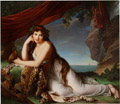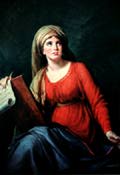 Emma Lyon (Lady Hamilton) had a modest origin. Her father was a black smith and her mother was a maid. Emma had to work hard as a child. At 14, Emma and her mother went to London. There, they looked for work and a better life. Emma worked in several
positions. She worked as a servant-girl at home of the composer Linley, selling fruits and also as a servant-girl in a house of the merchant named Kelly. While she was working in a inn, she met a Lieutenant named John Willet Payne, and she become his lover.
Emma Lyon (Lady Hamilton) had a modest origin. Her father was a black smith and her mother was a maid. Emma had to work hard as a child. At 14, Emma and her mother went to London. There, they looked for work and a better life. Emma worked in several
positions. She worked as a servant-girl at home of the composer Linley, selling fruits and also as a servant-girl in a house of the merchant named Kelly. While she was working in a inn, she met a Lieutenant named John Willet Payne, and she become his lover.
Willet educated Emma. At 17, Emma gave birth. The baby was raised and educated by
 her grand-mother. Unfortunately Payne fell upon hard times. His friend Featherstonehaugh paid his debts but he wanted Emma in exchange. Emma went to live in the wonderful castle of Up-Park, which was the property of Featherstonehauh. During this period she knew the famous painters Romney, Thomas Lawrence and Charles
Greville. She also met Greville's uncle, William Hamilton, English Ambassador in Naples and an important collector of art. Some time later, Featherstonehaugh lost his furtune, and Emma returned to London to look for work. She found work with a Doctor Graham who experimented with electric currents. Graham used Emma to entertain people. He dressed Emma as the Goddess Hygea. One of the people who visited the doctor to view
his famous electric experiments was Charles Greville. He had known Emma since 1782 and he was in love of her. Emma left her position with Doctor Graham to go with Greville. He wanted to make her into a lady so he changed her name. She became Mistress Hart and her mother Mistress Cadogan.
her grand-mother. Unfortunately Payne fell upon hard times. His friend Featherstonehaugh paid his debts but he wanted Emma in exchange. Emma went to live in the wonderful castle of Up-Park, which was the property of Featherstonehauh. During this period she knew the famous painters Romney, Thomas Lawrence and Charles
Greville. She also met Greville's uncle, William Hamilton, English Ambassador in Naples and an important collector of art. Some time later, Featherstonehaugh lost his furtune, and Emma returned to London to look for work. She found work with a Doctor Graham who experimented with electric currents. Graham used Emma to entertain people. He dressed Emma as the Goddess Hygea. One of the people who visited the doctor to view
his famous electric experiments was Charles Greville. He had known Emma since 1782 and he was in love of her. Emma left her position with Doctor Graham to go with Greville. He wanted to make her into a lady so he changed her name. She became Mistress Hart and her mother Mistress Cadogan.
 During this period, she made many visits to Romney's studio. He painted several fine portraits of her. Ambassador William Hamilton (Greville's uncle) returned from Naples to England where he fell in love with the lover of his nephew. William Hamilton, Greville and Emma were a very good friends. They usually went to parties and suppers together. They become well known society figures along with their friend Romney. This life style came to an end when Greville lost his fortune. He decided that marrying a woman millionaire would be a very good solution to his problem. He wished to marry a rich aristocrat from Edinburgh . Greville asked her to travel to Naples with his uncle. Emma refused to leave but she finally accepted. Emma often wrote to Greville but in time their relationship ended.
During this period, she made many visits to Romney's studio. He painted several fine portraits of her. Ambassador William Hamilton (Greville's uncle) returned from Naples to England where he fell in love with the lover of his nephew. William Hamilton, Greville and Emma were a very good friends. They usually went to parties and suppers together. They become well known society figures along with their friend Romney. This life style came to an end when Greville lost his fortune. He decided that marrying a woman millionaire would be a very good solution to his problem. He wished to marry a rich aristocrat from Edinburgh . Greville asked her to travel to Naples with his uncle. Emma refused to leave but she finally accepted. Emma often wrote to Greville but in time their relationship ended.
In Naples Emma became a popular member of high society. Goethe praised her grace and beauty. Everybody wanted to know her, including the King of Naples Ferdinand who was married to Maria Carolina sister of Marie Antoniette. Emma was presented to the King.
The relation between Emma and William Hamilton became more intimate and they soon became lovers. She was accepted by the Naples Court, by the Queen and the Prime Minister John Acton (Known as Giovanni Acton). Emma and William traveled to England and there they married in 6 September1791. EaOn their return from England to Naples, they stopped in Paris. At the time Queen Marie
Antoniette and Louis XVI were prisoners in the Palace of Tulleries. Emma wanted to help Marie Antoniette. She became the messenger between Marie Antoniette and her sister Maria Carolina.
and beauty. Everybody wanted to know her, including the King of Naples Ferdinand who was married to Maria Carolina sister of Marie Antoniette. Emma was presented to the King.
The relation between Emma and William Hamilton became more intimate and they soon became lovers. She was accepted by the Naples Court, by the Queen and the Prime Minister John Acton (Known as Giovanni Acton). Emma and William traveled to England and there they married in 6 September1791. EaOn their return from England to Naples, they stopped in Paris. At the time Queen Marie
Antoniette and Louis XVI were prisoners in the Palace of Tulleries. Emma wanted to help Marie Antoniette. She became the messenger between Marie Antoniette and her sister Maria Carolina.
 When Emma returned to Naples , she met the famous English Admiral Lord Nelson. There was a war going on between England and France and the Monarchy in Naples was in danger because Naples was full of partisans from the French Revolution. Emma often intervened in political affairs and always on behalf of English Government and English Fleet. Thanks to Emma, Lord Nelson obtained enough help from the Naples government to result in his triumph against the French in Abukir. The war against France continued and Napoleon Bonaparte soon arrived to Naples. Lord Nelson
helped the King of Naples and his wife escape to Palermo. Emma and
William traveled to England with Nelson's help. Nelson and Emma became lovers. Some months later Emma gave birth a baby. Her name was Horacia (as her father). Emma and Horace were known lovers. Their spouses accepted the situation but English society looked down on this relationship.
When Emma returned to Naples , she met the famous English Admiral Lord Nelson. There was a war going on between England and France and the Monarchy in Naples was in danger because Naples was full of partisans from the French Revolution. Emma often intervened in political affairs and always on behalf of English Government and English Fleet. Thanks to Emma, Lord Nelson obtained enough help from the Naples government to result in his triumph against the French in Abukir. The war against France continued and Napoleon Bonaparte soon arrived to Naples. Lord Nelson
helped the King of Naples and his wife escape to Palermo. Emma and
William traveled to England with Nelson's help. Nelson and Emma became lovers. Some months later Emma gave birth a baby. Her name was Horacia (as her father). Emma and Horace were known lovers. Their spouses accepted the situation but English society looked down on this relationship.
In April 1803 William Hamilton died and he passed his fortune on to nephew Greville and left only 100 liras to Emma. Emma had no penniless. Nelson arranged for her to live in his brother William's home. Emma wrote to Queen Maria Carolina requesting a small amount of money but unfortunately the Queen never replied. Emma was
ruined. Nelson died in the Battle of Trafalgar and his brother William didn't want to execute the testament of his brother Horace which most likely included Emma. Emma moved out and lived in misery. She went to the prison two times for debts. The letters written by Horace Nelson to Emma were discovered but family declared these letters forgeries. This was the end for Emma. She died in misery on 15 January 1815.
Mercè Alabern
Barcelona, Spain











